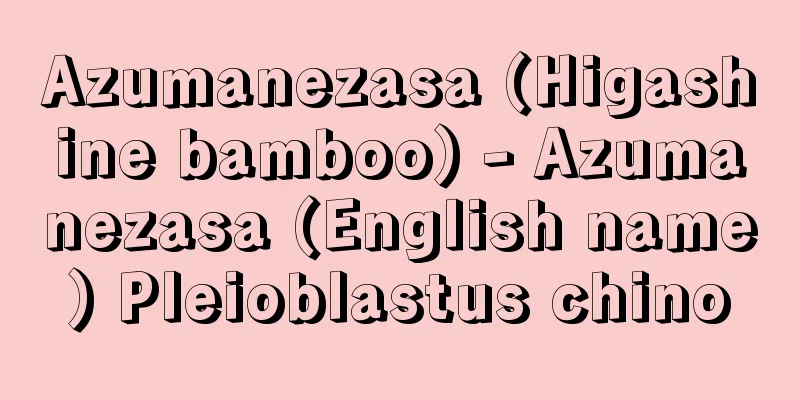Hibiya Park

|
A representative urban park located in Chiyoda Ward, Tokyo, southeast of the Imperial Palace. In the early Edo period, this was an inlet, but it was reclaimed and became the site of samurai residences, and the stone wall of the Hibiya Gate that was built at that time remains in the northeast corner. The Nabeshima family of the Saga domain and the Mori family of the Choshu domain were both home to residences here, but they were demolished in the early Meiji period and used as a military parade ground. In 1889 (Meiji 22), when the city was reorganized, it was designated a park, and in 1903, a large Western-style park was opened, modeled after Germany. It covers an area of 161,637 square meters. Shinji Pond, with its crane fountain near the stone wall, is a vestige of the moat inside Edo Castle, and to the south of it are the Small Music Hall and the Large Fountain, and to the west are the Kumogata Pond, the restaurant Matsumotoro, and the Large Music Hall. At the southern end of the park are the equilateral triangular Hibiya Library and Culture Center (formerly Hibiya Library), established in 1908 (Meiji 41), and Hibiya Public Hall, established in 1929 (Showa 4). There are two Western-style flower beds in the park, filled with seasonal flowers. There are also Japanese-style gardens surrounding two ponds. The Park Museum, designed as a bungalow-style park office, is a valuable example of Western-style architecture from the Meiji period. Located in the heart of the city, it has always been swept up in the waves of Japan's modern history, such as the Hibiya Riots in 1905 (Meiji 38) by a mob disgruntled by the Russo-Japanese Peace Treaty in Portsmouth, the speech by Ozaki Yukio in 1922 (Taisho 11) to promote universal suffrage, and the placement of heavy field artillery here during the February 26 Incident in 1936 (Showa 11). [Kiyoshi Sawada] Opened on June 1, 1903 (Meiji 36), this is Japan's first Western-style park. It serves as an oasis in the business district and a place of relaxation for the people. Chiyoda Ward, Tokyo ©Yutaka Sakano "> Hibiya Park Hibiya Park in Kojimachi Ward (present-day Hibiya Park in Chiyoda Ward, Tokyo). At the back left is the Daishinin Court, and at the right is the Ministry of Justice. "Tokyo Landscape" (1911, Meiji 44) owned by the National Diet Library . Hibiya Park (Meiji period) Source: Shogakukan Encyclopedia Nipponica About Encyclopedia Nipponica Information | Legend |
|
東京都千代田区、皇居の南東にある代表的な都市公園。江戸初期は入江であったが、埋め立てられ武家屋敷地となり、当時設けられた日比谷門の石垣が北東隅に残っている。佐賀藩鍋島(なべしま)家、長州藩毛利(もうり)家などの屋敷があったが、明治初年取り壊され練兵場となった。1889年(明治22)市区改正のとき公園と定められ、1903年ドイツを範として、大規模な西洋式公園が開園した。面積16万1637平方メートル。石垣近く、ツルの噴水のある心字(しんじ)池は江戸城内濠(うちぼり)の名残(なごり)で、その南に小音楽堂、大噴水、西方に雲形池、レストランの松本楼、大音楽堂がある。また南端に1908年(明治41)設立の正三角形の日比谷図書文化館(旧、日比谷図書館)、1929年(昭和4)設立の日比谷公会堂がある。公園内には二つの西洋花壇があり、四季の花が咲き誇っている。そのほか、二つの池を囲んで日本式庭園がある。公園事務所として設計されたバンガロー形式の公園資料館は明治時代の洋風建築物として貴重である。 1905年(明治38)のポーツマス日露講和条約に不平をもった群衆の日比谷焼打事件、1922年(大正11)普通選挙法促進のための尾崎行雄(ゆきお)の演説、また1936年(昭和11)の二・二六事件では野戦重砲が置かれるなど、都心にあってつねに日本の近代史の波にもまれてきた。 [沢田 清] 1903年(明治36)6月1日に開園した日本初の西洋式公園。ビジネス街のオアシスとして、人々のいこいの場となっている。東京都千代田区©Yutaka Sakano"> 日比谷公園 麹町区日比谷公園(現在の東京都千代田区日比谷公園)。後方左は大審院、右は司法省。『東京風景』(1911年〈明治44〉)国立国会図書館所蔵"> 日比谷公園(明治時代) 出典 小学館 日本大百科全書(ニッポニカ)日本大百科全書(ニッポニカ)について 情報 | 凡例 |
>>: Behemoth; The Structure and Practice of National Socialism
Recommend
Kibana Mokuwanju - Kibana Mokuwanju
... B . purpurea L. (also known as Murasakisosink...
Sinai alphabet - Shinai characters
An early alphabetic character discovered in 1905 ...
Alcohol Intolerance
…The amount of alcohol consumed varies, but patho...
《Answer to Correspondents》
At the age of 16, he began writing for several Lo...
Flare Star - Flare Star
Also called a flashing star. A type of variable st...
(R)Im Che
1549‐87 A writer from the mid-Yi Dynasty of Korea....
Shimazu Yoshihiro
A military commander from the Sengoku period to t...
Punishment Day - Punishment Peeping
…There was no system of appeal, and the only way ...
Isbahan - Isbahan
...Population: 1.22 million (1994). The correct p...
British Films
Cinema was born in Britain in the 19th century, i...
Dendrobium tetragonum
…[Koichi Ejiri]. … *Some of the terminology that ...
Lake Izu
This swamp is located in the northern part of Miy...
Jaw Bill Eyes - Jaw Bill Eyes
…Freshwater and marine species are known, includi...
Multiple fission
…Mature cells rejuvenate by division, so in singl...
Book - Hon
[1] (In Chinese, it originally meant the roots of ...









